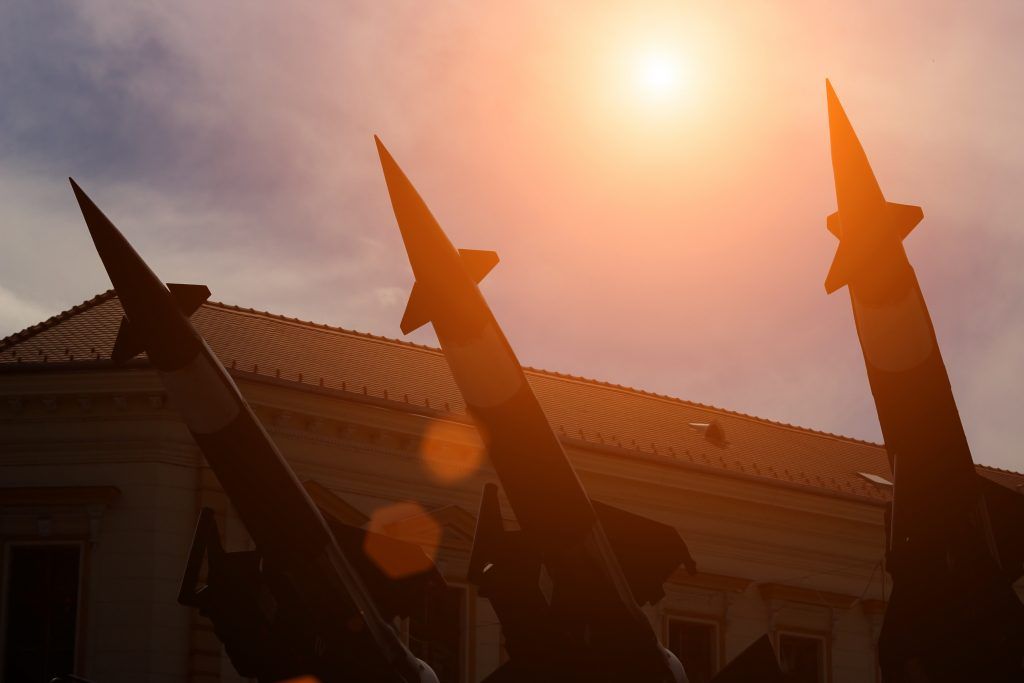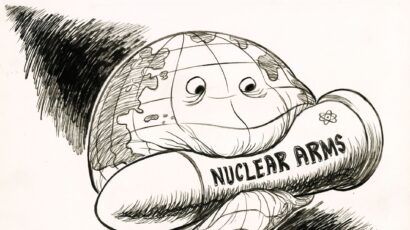The nuclear threat in 2017
By John Mecklin | December 23, 2017

It was a year stained by the epithets “little rocket man” and “dotard” and full of all-too-many nuclear threats. Beyond the confrontation between North Korea and the United States over Pyongyang’s nuclear program, in 2017 the strained US-Russia relationship, the Iran nuclear deal, nuclear modernization programs around the world, the India-Pakistan nuclear arms race, and even the mental state of the US president dominated world headlines. On a positive note (at least as seen by supporters of nuclear disarmament), the UN overwhelmingly adopted a treaty to ban nuclear weapons. But because the countries with nuclear weapons steadfastly refused to support the ban, it received a relatively dismissive reception in the United States—until the leaders of the treaty effort received the Nobel Peace Prize for their work.
The Bulletin offered voluminous and deep coverage of these and many other nuclear security issues in 2017. Below are a dozen of our stories on nuclear weapons that happened to gain wide notice in the year past. A couple of dozen equally worthy articles could easily have made the list. The full selection of an especially strong year of Bulletin nuclear affairs coverage can be found here.
By Hans M. Kristensen, Matthew McKinzie, and Theodore A. Postol
Three top experts explain why a new fuzing system for US submarine-based nuclear missiles has created a deeply destabilizing and dangerous nuclear situation in which Russia could perceive that the United States is pursuing a first-strike capability.
North Korea’s “not quite” ICBM can’t hit the lower 48 states
By Theodore A. Postol, Markus Schiller, and Robert Schmucker
This ground-breaking article questioned whether the North Koreans had the ability to target the US mainland with a nuclear-tipped missile last summer. The question remains.
Through a fractured looking-glass: Trump’s nuclear decisions so far
By Sharon Squassoni
A Bulletin Science and Security Board member assesses President Trump’s performance in regard to nuclear weapons policy.
Time to insert the control rods on North Korea
By Siegfried S. Hecker
Cool-headed individuals on both sides can help diffuse the dangerous rise in tension between Washington and Pyongyang.
Overview: The Treaty on the Prohibition of Nuclear Weapons
A guide to the Bulletin‘s deep coverage of the nuclear weapons ban treaty.
By John Mecklin
Shoddy translation in the Western media is increasing nuclear tensions–again
By Ariane Tabatabai
Western, English-language journalism on Iranian nuclear affairs suffers from misunderstandings and mistakes that needlessly create misunderstandings and heighten tension in the Middle East.
The right planning now will save countless lives after a nuclear attack
By D. Hanfling, F.M. Burkle, and C. Dallas
The public perception that there is no hope for surviving a nuclear attack has been an impediment to planning for the aftermath of such disasters.
The ambiguity challenge: Why the world needs a multilateral nuclear cruise missile agreement
By Christine Parthemore
The US long-range standoff (LRSO) weapon program is clearly a major factor in the worldwide trend toward fielding nuclear-armed cruise missiles.
The political and military vulnerability of America’s land-based nuclear missiles
By Jon B. Wolfsthal
A former National Security Council official and Bulletin Science and Security Board member questions the current plan to replace the United States’ aging Minuteman III missiles with next-generation missiles known as the Ground-Based Strategic Deterrent, at a cost of $100 billion or more.
South Asia is not the most dangerous place on Earth
By Ramamurti Rajaraman
While the nuclear situation between India and Pakistan is not good, the West has over-dramatized the possibility of nuclear war in South Asia, a noted physicist from the region and Bulletin Science and Security Board member writes.
Mini-nukes: Still a bad choice for the United States
By James E. Doyle
Proponents of mini-nukes, or of vague “limited nuclear options,” offer no convincing evidence that the United States needs new weapons in this category—or that they would make anyone safer.
Reconsidering the nuclear demigod called Mr. President
By John Mecklin
The simmer of unease prompted by the prospect of Donald Trump in command of nuclear weapons—initially highlighted during last year’s presidential campaign—reached full boil in 2017. This article rounds up a wide variety of coverage on the US president’s authority to launch nuclear weapons, and on efforts in and outside Congress to constrain that authority.
Together, we make the world safer.
The Bulletin elevates expert voices above the noise. But as an independent nonprofit organization, our operations depend on the support of readers like you. Help us continue to deliver quality journalism that holds leaders accountable. Your support of our work at any level is important. In return, we promise our coverage will be understandable, influential, vigilant, solution-oriented, and fair-minded. Together we can make a difference.
Topics: Analysis, Nuclear Weapons















